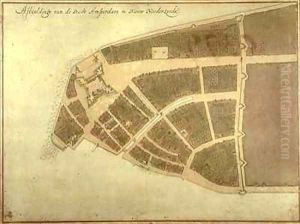Jacques Cortelyou Paintings
Jacques Cortelyou was not primarily known as an artist in the traditional sense but was a prominent figure in early American history as a surveyor, educator, and cartographer. Born around 1625, likely in the Netherlands, Cortelyou came to New Netherland, which would later become New York, under Dutch rule during the 17th century.
Cortelyou's expertise as a surveyor and his knowledge of land were highly valued in the New World, where accurate mapping and land allocation were crucial for settlement and development. One of his most significant contributions was the creation of the Castello Plan, a detailed map of New Amsterdam (now Lower Manhattan) in 1660. This map is invaluable for historians as it provides a comprehensive view of the city's layout and structures during the Dutch colonial period.
Aside from his work in surveying and cartography, Jacques Cortelyou also served in various administrative roles within the colony. He was an advisor to Peter Stuyvesant, the last Dutch Director-General of New Netherland, and held positions such as schoolmaster and town clerk, which allowed him to influence the educational and bureaucratic frameworks of the time.
Cortelyou's death is recorded in 1693, by which time New Netherland had become a part of the English colonies. His legacy is preserved not only through the Castello Plan but also through his involvement in the founding and development of various settlements, including New Utrecht, which is now a neighborhood in Brooklyn, New York. Although Cortelyou is not remembered primarily for artistic endeavors, his contributions to early American cartography are a lasting testament to his skills and influence during a formative period in American history.
